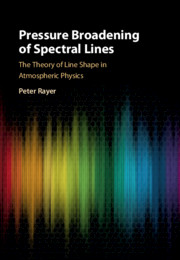Book contents
- Frontmatter
- Dedication
- Contents
- Preface
- Part One Preparing the Way
- Part Two Broadening Theory
- 4 Isolated Lines
- 5 Overlapping Lines
- 6 Liouville Formalism
- Part Three Atmospheric Spectra
- Part Four The Background
- Appendix 1 State Space
- Appendix 2 Product Space
- Appendix 3 Projectors
- Appendix 4 Vector Operators
- Appendix 5 Quantum Dynamics
- Appendix 6 Scattering Theory
- Appendix 7 Resolvent Methods
- Appendix 8 Linear Response
- Appendix 9 Correlation Function
- Appendix 10 Complex Time
- Appendix 11 Absorption
- Appendix 12 Multipole Moments
- Appendix 13 Angular Momentum
- Appendix 14 The Wigner–Eckart Theorem
- Appendix 15 Reduced Amplitudes
- Appendix 16 Units and Other Matters
- Appendix 17 Plasma Spectra: Pointers
- Notes
- References
- Index
4 - Isolated Lines
from Part Two - Broadening Theory
Published online by Cambridge University Press: 26 June 2020
- Frontmatter
- Dedication
- Contents
- Preface
- Part One Preparing the Way
- Part Two Broadening Theory
- 4 Isolated Lines
- 5 Overlapping Lines
- 6 Liouville Formalism
- Part Three Atmospheric Spectra
- Part Four The Background
- Appendix 1 State Space
- Appendix 2 Product Space
- Appendix 3 Projectors
- Appendix 4 Vector Operators
- Appendix 5 Quantum Dynamics
- Appendix 6 Scattering Theory
- Appendix 7 Resolvent Methods
- Appendix 8 Linear Response
- Appendix 9 Correlation Function
- Appendix 10 Complex Time
- Appendix 11 Absorption
- Appendix 12 Multipole Moments
- Appendix 13 Angular Momentum
- Appendix 14 The Wigner–Eckart Theorem
- Appendix 15 Reduced Amplitudes
- Appendix 16 Units and Other Matters
- Appendix 17 Plasma Spectra: Pointers
- Notes
- References
- Index
Summary
The focus here is on the approach taken by Anderson, which extends previous work by including the possibility that collisions will cause transitions in the radiator. Anderson confines himself to spectral lines that may be considered isolated from one another, and will, therefore, be broadened independently, and the start point is the correlation function of the radiatively active dipole, a quantum mechanical average formed from the states and operators of the gas system. This is treated as an ensemble average, in line with later chapters, and Anderson’s use of a time average is relegated to an appendix. However, the two approaches eventually converge, and both lead to a concern for the average effect on the lines as the radiator encounters an ensemble of single binary collisions on classical trajectories. Under the impact approximation, the correlation function may be greatly simplified, and expressions arise for the shift and width of a spectral line in terms of an optical cross-section that may be approached through a low order perturbative approximation. Within this, contributions due to phase shifts, elastic reorientations and inelastic transfers may all be distinguished.
Keywords
- Type
- Chapter
- Information
- Pressure Broadening of Spectral LinesThe Theory of Line Shape in Atmospheric Physics, pp. 95 - 128Publisher: Cambridge University PressPrint publication year: 2020



